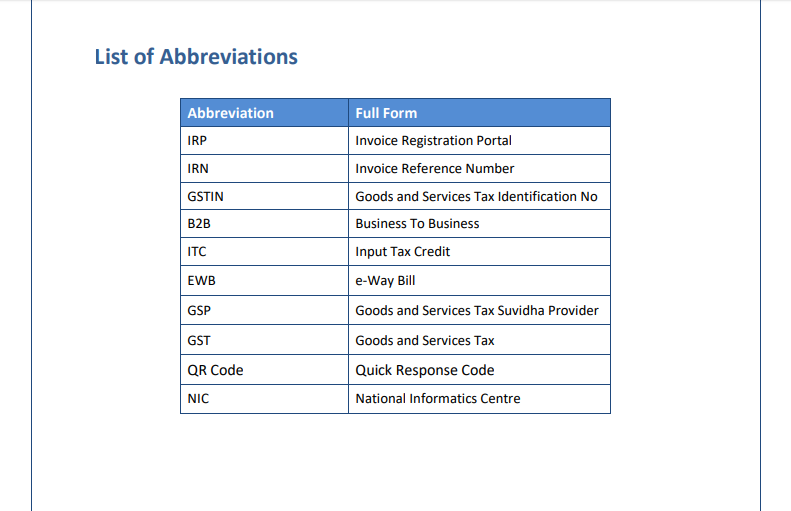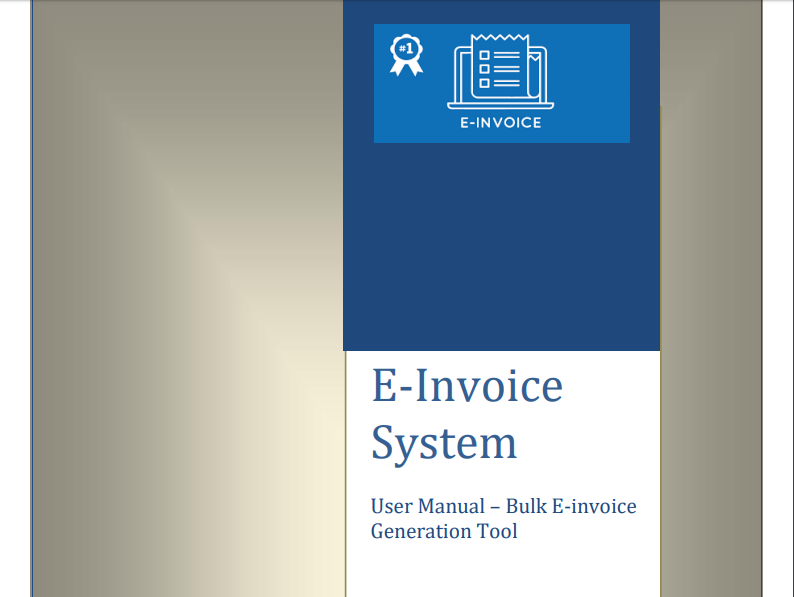E-Invoice System User Manual – Bulk E-invoice Generation Tool: NIC
Table of Contents
E-Invoice System User Manual – Bulk E-invoice Generation Tool
List of Abbreviations
 1. Introduction
1. Introduction
1.1 Background
The GST Council has approved the introduction of ‘E-invoicing’ or ‘electronic invoicing’ in a phased manner for reporting of business to business (B2B) invoices to GST System, starting from 1st January 2020 on a voluntary basis.
Since there was no standard for e-invoice existing in the country, a standard for the same has been finalized after consultation with trade/industry bodies as well as ICAI after keeping the draft in public place. Having a standard is a must to ensure complete interoperability of e-invoices across the entire GST eco-system so that e-invoices generated by one software can be read by any other software, thereby eliminating the need for fresh data entry – which is a norm and standard expectation today. The machine readability and uniform interpretation is the key objective. This is also important for reporting the details to the GST System as part of Return. Apart from the GST System, adoption of a standard will also ensure that an e-invoice shared by a seller with his buyer or bank or agent or any other player in the whole business eco-system can be read by machines and obviate and hence eliminate data entry errors.
The GST Council approved the standard of e-invoice in its 37th meeting held on 20th Sept 2019 and the same along with schema has been published on the GST portal. Standards are generally abstruse and thus an explanation document is required to present the same in common man’s language. Also, there are a lot of myths or misconceptions about e-Invoice. The present document is an attempt to explain the concept of e-invoice, how it operates and the basics of standards.
E-invoicing in India will be a big move, due to the volume of business transactions undertaken every day, as well as the plethora of different, non-standardized formats used in invoice generation. The main objective is to enable interoperability across the entire GST eco-system i.e. an e-invoice generated by one software should be capable of being read by any other software. Basically, through machine readability, an invoice can be uniformly interpreted.
In addition to the above, this new system of e-invoicing aims to make invoice reporting an integral part of a business process and remove the tedious task of invoice-compilation at the end of a return period. Claiming fictitious Input Tax Credit (ITC) by raising fake invoices is also one of the biggest challenges currently faced by tax authorities.
The e-invoice system will help to curb the actions of unscrupulous taxpayers and reduce the number of fraud cases as the tax authorities will have access to data in real-time. The basic aim behind the adoption of the e-invoice system by tax departments is the ability to pre-populate the return and to reduce the reconciliation problems.
Related Topic:
Accounting procedure of e-commerce operators and applicability of sec 52 of GST (TCS)
1.2 Purpose and Intended Audience
This document aims to explain the operational procedure on how to use offline tools to generate the bulk e-invoice generation. It is expected that the document will also be useful for the taxpayers, tax consultants and software companies to adopt the designed standard.
This document aims to explain the operational procedure on how to use an offline tool to generate bulk e-invoices.
This document is intended for registered taxpayers under GST, who are the main stakeholders of the e-invoice system under GST.
1.3 Scope
The scope of this document covers:
• What is E-invoice
• Using Invoice Bulk Upload tool
1.4 URL or Web site address
IRP (Invoice Registration Portal)
2. What is E-invoice?
E-Invoicing is a process in which all the invoices created by accounting software will be authenticated electronically by GSTN for further use (like return preparation, E-way bill creation).
There are lots of myths or misconceptions about e-invoice. E-Invoice does not mean generation /creation of invoice from a central portal or tax department because practically it is not possible it will create unnecessary restrictions on trade and industry and different industries have different business requirements, which cannot be met out by software.
E-Invoice is a submission of already generated Invoices from accounting software to GST Portal and we all are aware that there are hundreds of accounting & billing software, which generate invoices, but they all use their own formats to store information electronically and data in such different-different formats cannot understand by the GST System, hence it was not possible to submit the data from accounting software (Like ERP/Tally/SAP) to GST System.
So, need was felt to issue a standard format (Schema) in which data will be shared with other systems, although from a user perspective it’s the same as earlier, there would not any change in print or electronically creation of an invoice. Only standard schema needs to be implemented by all the accounting and billing software so that it can generate JSON of each invoice in such format which can be uploaded on GST Portal for further authentication and approval.
Download the copy:
 ConsultEase Administrator
ConsultEase Administrator
Consultant
Faridabad, India
As a Consultease Administrator, I'm responsible for the smooth administration of our portal. Reach out to me in case you need help.








